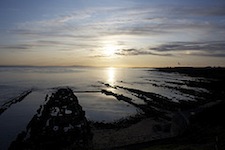SEAMUS CREAGH

Seamus Creagh
Biography
From the CD Booklet " Seamus Creagh, Aidan Coffey "
Seamus Creagh was born into a farming family in Killucan, County Westmeath, in 1946. He grew up in an inviroment that was, at best, indifferent to traditional music. Showbands ruled the musical landscape, and traditional music was seen as the remnant of an impoverished past. Seamus recalls hearing that a granduncle, whom he never met, had once played the fiddle.
Two neighbours were to play a part in his musical development. The first, Larry Ward, was a fiddle player, although his repertoire was not traditional and consisted almost exclusively of waltzes, quicksteps and fox-trots. The other was Nicholas Moore, who left a tin whistle behind in the Creagh household. Seamus came accross it, and started picking out tunes.
He studied violin in Mullingar for six months or so but " that didn'd suit at all, it was way to rigid ".
He learned the pieces by heart, and inserted parts of his own making, hardly a recipe for success in the world of classical violin.His greatest outside influence in those pre-television, pre-cassette days was the radio. However he paid regular visits to Larry Ward, whose teaching methods were informal, and who used a similar tablature method to that of the Sliabh Luachra fiddle master, Padraig O'Keefe.
In his late teens , Seamus discovered O'Donoghue's Pub in Dublin, which was a regular haunt for traditional musicians such as John Kelly, Joe Ryan, Ted Furey and Seamus Ennis, and thus began a weekly pilgrimage. He had put his fiddle to one side at the time and was more interested in football, hurling and shooting. His only musical involvement lay in playing electric guitar with a local showband.The O'Donohue's session drew him in the direction of traditional music. " I started listening, picking up bits and pieces, nearly unconsiously. Ted Furey gave me a lot of tips ".
Although he lived in London ( where he combined working in the construction trade with a bit of busking ) at a time when the Beatles and Rolling Stones were at the peak of their popularity, the Swinging Sixties passed Seamus by. Nevertheless, music was becoming a central part of his life. On his return to Dublin, he joined a ballad group called the Dragons where , on his own admission, he " battered a guitar for two years ".On the demise of the group in 1967, he went to Baltimore in West Cork for what was intended to be a weekend break. It was to change his life.
You can listen to short samples from some of the tracks from this artist using the player below.
Releases
ACCOUNT
SHOPPING CART
You have no items in your order.
MAILING LIST
TOP SELLERS
- Órach
The Tannahill Weavers
CD: £12.15 - In Praise of Home
Rura
CD: £11.80 - Beyond
Talisk
CD: £10.29 - St. Kilda Wedding
Ossian
Download: £7.00 - Osgarra
Beinn Lee
CD: £11.80 - 100 Scottish Greats
Various Artists
4xCD: £9.40 - Sleeper
Kan
CD: £12.60 - Songs Of The Jacobites -Vol 2
Kenneth McKellar - Evo
Skerryvore
CD: £10.00 - Cavalier
Eddi Reader
CD: £10.00
YOUTUBE
We have a YouTube channel where you can watch some of the celtic music related videos we've found.www.youtube.com/allcelticmusic
Threads of Sound
The downloads on this site are provided by Threads of Sound. They also distribute music to iTunes, eMusic, Spotify and many others. If you want to sell your music on all celtic then you register it via Threads of Sound.www.threadsofsound.net

MASTHEAD
Our current header image was taken by Nick Bramhall and you can find the original here.Privacy Policy | Terms & Conditions | Contact Us
© Threads of Sound Music Services Limited. T/A All Celtic Music - Registered in Scotland no. 475134
